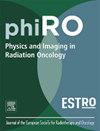Dose-response mapping of bladder and rectum in prostate cancer patients undergoing radiotherapy with and without baseline toxicity correction
IF 3.3
Q2 ONCOLOGY
引用次数: 0
Abstract
Background and purpose
Radiotherapy dose–response maps (DRM) combine dose-surface maps (DSM) and toxicity outcomes to identify high-risk subregions in organ-at-risk. This study assesses the impact of baseline toxicity correction on the identification of high-risk subregions in dose–response modeling for prostate cancer patients undergoing radiotherapy.
Materials and methods
The analysis included 1808 datasets, with 589 exclusions before toxicity-specific data removal. Bladder/rectum were automatically segmented on planning computed tomography scans, DSMs unwrapped into 91x90 voxel grids, and converted to equivalent doses in 2 Gy fractions (EQD2; α/β = 1 Gy). Seventeen late toxicities were assessed with two methods: (i) baseline toxicity subtracted from the maximum of 12- and 24-months toxicity scores, dichotomized at grade 1, and (ii) maximum of 12- and 24-months toxicity scores dichotomized at grade 1. DSMs were split accordingly, and voxel-wise t-values computed using Welch’s t-equation. Statistically significant voxels were identified via the 95th percentile of maximum of t-value (Tmax) distribution.
Results
Event counts with baseline correction were 82/82/286/226 for urinary tract obstruction/retention/urgency/incontinence, respectively; without baseline correction, they were 93/104/465/361. For bladder DSMs, urinary incontinence, obstruction, retention, and urgency had 1143/186, 1768/1848, 516/0, and 33/0 significant voxels without/with baseline correction. For rectum DSMs, urinary incontinence and tract obstruction had 604/0 and 1980/889 significant voxels without/with baseline correction. However, no significant associations between rectal DSMs and rectum-related toxicities were found.
Conclusions
DRM without baseline correction appears more sensitive to high-risk subregions due to higher event counts. Non-linear toxicity grading and multivariable analysis may enhance DRM reliability.
接受放射治疗的前列腺癌患者膀胱和直肠的剂量反应图,有和没有基线毒性校正
背景和目的放射治疗剂量-反应图(DRM)结合剂量-表面图(DSM)和毒性结果来确定器官高危亚区。本研究评估基线毒性校正对放射治疗前列腺癌患者剂量反应模型中高危亚区识别的影响。材料和方法分析包括1808个数据集,在毒性特定数据删除之前排除了589个数据集。膀胱/直肠在计划计算机断层扫描中自动分割,dsm展开成91x90体素网格,并转换成2 Gy分量的等效剂量(EQD2;α/β = 1 Gy)。采用两种方法评估17种晚期毒性:(i)从12个月和24个月的最大毒性评分中减去基线毒性,在1级时进行二分,(ii) 12个月和24个月的最大毒性评分在1级时进行二分。dsm被相应地分割,并使用Welch的t方程计算逐体t值。通过最大t值(Tmax)分布的第95个百分位确定具有统计学意义的体素。结果基线校正后尿路阻塞/尿潴留/尿急/尿失禁的事件计数分别为82/82/286/226;未经基线校正,它们分别为93/104/465/361。膀胱dsm中,尿失禁、梗阻、尿潴留和尿急的显著体素分别为1143/186、1768/1848、516/0和33/0。在直肠dsm中,尿失禁和尿道梗阻的显著体素分别为604/0和1980/889。然而,直肠DSMs和直肠相关毒性之间没有明显的关联。结论未进行基线校正的sdrm对高危亚区更为敏感,事件数较高。非线性毒性分级和多变量分析可以提高DRM的可靠性。
本文章由计算机程序翻译,如有差异,请以英文原文为准。
求助全文
约1分钟内获得全文
求助全文
来源期刊

Physics and Imaging in Radiation Oncology
Physics and Astronomy-Radiation
CiteScore
5.30
自引率
18.90%
发文量
93
审稿时长
6 weeks
 求助内容:
求助内容: 应助结果提醒方式:
应助结果提醒方式:


